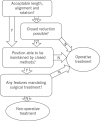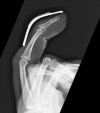Acute hand injury splinting - the good, the bad and the ugly
- PMID: 29182002
- PMCID: PMC5838697
- DOI: 10.1308/rcsann.2017.0195
Acute hand injury splinting - the good, the bad and the ugly
Abstract
Injuries to the hand comprise 20% of all emergency department attendances, with an estimated annual treatment cost of over £100 million in the UK. The initial assessment and management of hand injuries is usually undertaken by junior staff, many of whom have little or no training or experience in splinting hand fractures. In the Department of Orthopaedic Hand Surgery, Morriston Hospital, we regularly observe patients presenting to the specialist hand fracture clinics having had initial management that shows no appreciation for the treatment objectives or the safe positions for splinting. This article aims to provide guidance for frontline staff on the management of hand fractures, with particular emphasis on the appropriate nonoperative care to avoid any unnecessary morbidity.
Keywords: Fractures; Hand injury; Splints.
Figures








References
-
- Dias J. Hand injury costs. Injury 2006: : 1,071–1,077. - PubMed
-
- Miles SH. The Hippocratic Oath and the Ethics of Medicine. Oxford: Oxford University Press; 2004.
-
- Court-Brown CM. Principles of nonoperative fracture treatment : Rockwood and Green's Fractures in Adults. 8th ed Philadelphia: Lippincott Williams and Wilkins; 2015. pp125–161.
-
- Shewring D, Miller A, Ghandour A. Condylar fractures of the proximal and middle phalanges. J Hand Surg Eur 2015; (1): 51–58. - PubMed
-
- Capo J, Shamian B, Lim P. Corrective osteotomy and local bone grafting for extra-articular malunion of the proximal phalanx. Hand Surg 2012; (3): 399–403. - PubMed
Publication types
MeSH terms
LinkOut - more resources
Full Text Sources
Other Literature Sources
Medical
Research Materials

